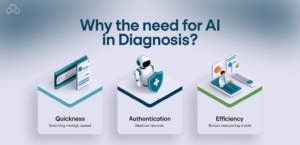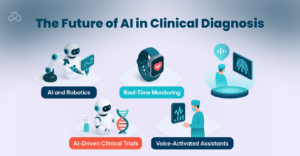Introduction: The Rise of AI in Clinical Diagnosis
Imagine walking into a hospital and being checked-up within minutes not by a doctor, but by a highly intelligent AI bot that never sleeps, never forgets, and learns every day. Magic? No! Well, it’s the future that is already here. A fast-growing branch of artificial intelligence tree- in healthcare is Clinical AI, which is revolutionizing how hospitals checkup, diagnose, and treat diseases. From analyzing X-rays to detecting early signs of cancer or forecasting patient deterioration, AI-used bots are helping doctors to make better decisions more accurately.
In this blog, we will explore how AI is working in clinical diagnosis, its benefits, the technologies behind it, and how the future looks for automated healthcare.
What Is Clinical AI?
Clinical AI is the use of artificial intelligence technologies, such as machine learning and natural language processing, to assist in medical diagnosis and decision-making. These intelligent systems can study a huge amount of health data like patient history, lab reports, and imaging scans to spot patterns that professional doctors might miss.
AI-powered bots don’t just “store” data- but they learn from it. The more data they process, the smarter they become. This makes them best companions for automated healthcare professionals working in high-pressure environments.
Why the Need for AI in Diagnosis?

Today hospitals are facing many challenges like overburdened staff, increasing patient loads, and a shortage of skilled medical professionals. Simultaneously, diseases are becoming more difficult, and accurate diagnosis is more complex than ever.
And here is where clinical AI comes into the picture:
-
Quickness: Bots can scan thousands of medical records or images in a few seconds.
-
Authentication: AI minimizes human error and enhances diagnostic accuracy.
-
Efficiency: Doctors save time and can focus on treatment, while bots can handle data analysis.
Real-World Applications of AI in Diagnosis
Let’s look at how hospitals around the world that are using AI-powered bots in real scenarios:
1. Medical Imaging Interpretation
AI bots are now better than humans at interpreting X-rays, MRIs, and CT scans. For example, Google’s DeepMind built an AI that can detect 50+ eye diseases as right as expert ophthalmologists could. Similarly, AI can identify tumors in mammograms or lung cancer in CT scans with a high accuracy.
2. Early Disease Detection
Early diagnosis can save many lives. Clinical AI is now used to detect diseases like Alzheimer’s, diabetes, and cancer even before the symptoms appear. These bots can analyze small changes in biomarkers or imaging results that might go missed by doctors.
3. Predictive Diagnosis
Some AI systems are trained to predict health risks before they happen. For instance, an AI can get a heart patient’s ECG and forecast a possible cardiac arrest which gives doctors a chance to find out before it’s too late.
4. Virtual Symptom Checkers
Many hospitals are using AI chatbots to collect symptoms and guide the patients to the right specialist. These bots ask relevant questions to analyze responses, and give a related diagnosis or recommendation for a medical test.
How AI Works in Clinical Diagnosis
Here is a simple version of how clinical AI bots works:
-
Data Collection: The bot collects patient information like symptoms, vital signs, lab results, or scan images.
-
Data Analysis: Using algorithms to compare the data with thousands of same medical cases.
-
Pattern Recognition: The bot analyses the patterns or markers that match exact conditions.
-
Prediction: It suggests a related diagnosis, risk level, or even the best medical step.
-
Recommendation: The final report is shared with the medical team for review and further action.
AI does not follow fixed rules like old software- it keeps evolving with every case it works on.
Benefits of AI-Powered Bots in Hospitals
Let’s highlight the some benefits of using clinical AI in hospitals:
Faster Decision-Making
AI can deliver reports within a fraction of seconds. This quick analysis is important in emergency rooms and critical care units, where every second matters.
Reduced Human Error
AI consistently delivers high-accuracy results by analyzing data without emotional bias. Whether it’s fatigue, distraction, or cognitive overload which can lead to misdiagnosis.
Personalized Treatment Plans
By analysing patient reports, genetics, lifestyle, and response to previous treatments, AI helps doctors to create customized treatment plans which improve recovery rates.
Scalability in Remote Areas
AI-based diagnosis tools can be used in rural clinics where professional doctors may not be available. Bots fill the gap between healthcare and underdeveloped regions.
Cost Reduction
While beginning setup can be expensive, AI systems help hospitals save money over time by optimizing resources, minimizing unnecessary tests, and reducing hospital beds.
Challenges and Ethical Concerns
Every coin has two sides so do AI has its own- AI isn’t without its challenges:
-
Data Privacy: Managing sensitive health data needs robust security and compliance with regulations like HIPAA.
-
Bias in AI Models:, AI may offer false diagnosis for certain ethnic or age groups if worked on biased data.
-
Lack of Human Touch: While bots are efficient, but they can not replace human empathy and doctor-patient relationships.
-
Over-Reliance on Technology: Doctors must remember that AI can be a support tool not a replacement for humans.
Hospitals must check that AI works hand-in-hand with medical experts, not independently.
Role of AI Services Company in Healthcare
Behind every clinical AI system, there’s an AI services company that offers the technology, training, and support. These companies specialize in:
- Generating medical-grade AI algorithms
- Checking regulatory compliance
- Adding AI into hospital systems (EHR, radiology, etc.)
- Providing cloud-based platforms for easy access and collaboration
Top leaders like IBM Watson Health, Google Health, and Microsoft Azure Healthcare are making a huge change in automated healthcare by collaborating with hospitals globally.
The Future of AI in Clinical Diagnosis

We are just looking at the surface of what clinical AI can achieve. Here’s what the future may look like:
AI and Robotics
Robots powered by AI could perform diagnostics and even small procedures autonomously in the future.
Real-Time Monitoring
In case of abnormalities wearable devices can be integrated with AI to continuously monitor patient vitals and alert doctors.
AI-Driven Clinical Trials
AI bots can help to identify suitable candidates for clinical trials for speeding up research and approval of new drugs.
Voice-Activated Assistants
AI voice bots will soon help doctors during surgery by pulling up reports, images, and suggestions.
Success Stories from Hospitals Using Clinical AI
Mayo Clinic
Mayo Clinic uses AI to forecast patient deterioration and ICU readmission risks. This helps in before care and reduces fatalities.
Apollo Hospitals (India)
Apollo uses AI for cardiac risk assessment. Their AI-based tool predicts heart attacks five years early with over 80% accuracy.
Mount Sinai Hospital (New York)
Mount Sinai uses deep learning models to understand electronic health records and predict diseases like kidney failure before they happen.
How to Implement Clinical AI in Your Hospital
For hospitals or clinics planning to use clinical AI, here’s a step-by-step roadmap:
-
Identify Pain Points: Choose areas where diagnosis delays or issues are high.
-
Collaborate with AI Services Company: Collaborate with firms that have specialized in artificial intelligence healthcare.
-
Pilot and Train: Start with a small pilot, train staff, and analyse results.
-
Check Compliance: Meet all legal and data security regulations.
-
Grow Gradually: Once it’s done effectively, move towards AI across more departments.
Conclusion: A Smarter, Healthier Tomorrow
AI-powered bots cannot replace doctors. They are here to support them to analyze faster, to detect earlier, and help save more lives. Clinical AI is the backbone of the future of AI in healthcare.
Hospitals that use this change will not only improve patient care but also optimize their operations. As we look further, it’s clear that the collaboration of medicine and machine learning is turning out smarter, more connected, and more reliable in the healthcare ecosystem.
So, whether you’re in the hospital industry, a healthcare provider, or just someone eager about innovation in medicine, remember this- the future of diagnosis is no longer in the doctor’s eyes only. It’s in the algorithm’s heart, as well.
Frequently Asked Questions
Q1. Can AI replace doctors in diagnosis?
No, AI is a tool to help doctors, not to replace them. Humans have empathy that is still crucial in healthcare.
Q2. Is clinical AI safe and accurate?
Yes, when trained and tested properly, clinical AI systems can deliver high accuracy but often outperforming human counterparts in certain tasks like image analysis.
Q3. Are AI-powered bots used in Indian hospitals?
Yes. Hospitals like Apollo, Fortis, and AIIMS are highly opting for AI to diagnosis and treatment planning.
Q4. How can small clinics use AI?
Many AI tools are now available as cloud-based or SaaS solutions, making them affordable for smaller healthcare providers.
Q5. What is the cost of setting up AI diagnosis in a hospital?
It varies based on the complexity and scale. However, long-term ROI is high due to improved outcomes and operational efficiency.
Do you like to read more educational content? Read our blogs at Cloudastra Technologies or contact us for business enquiry at Cloudastra Contact Us